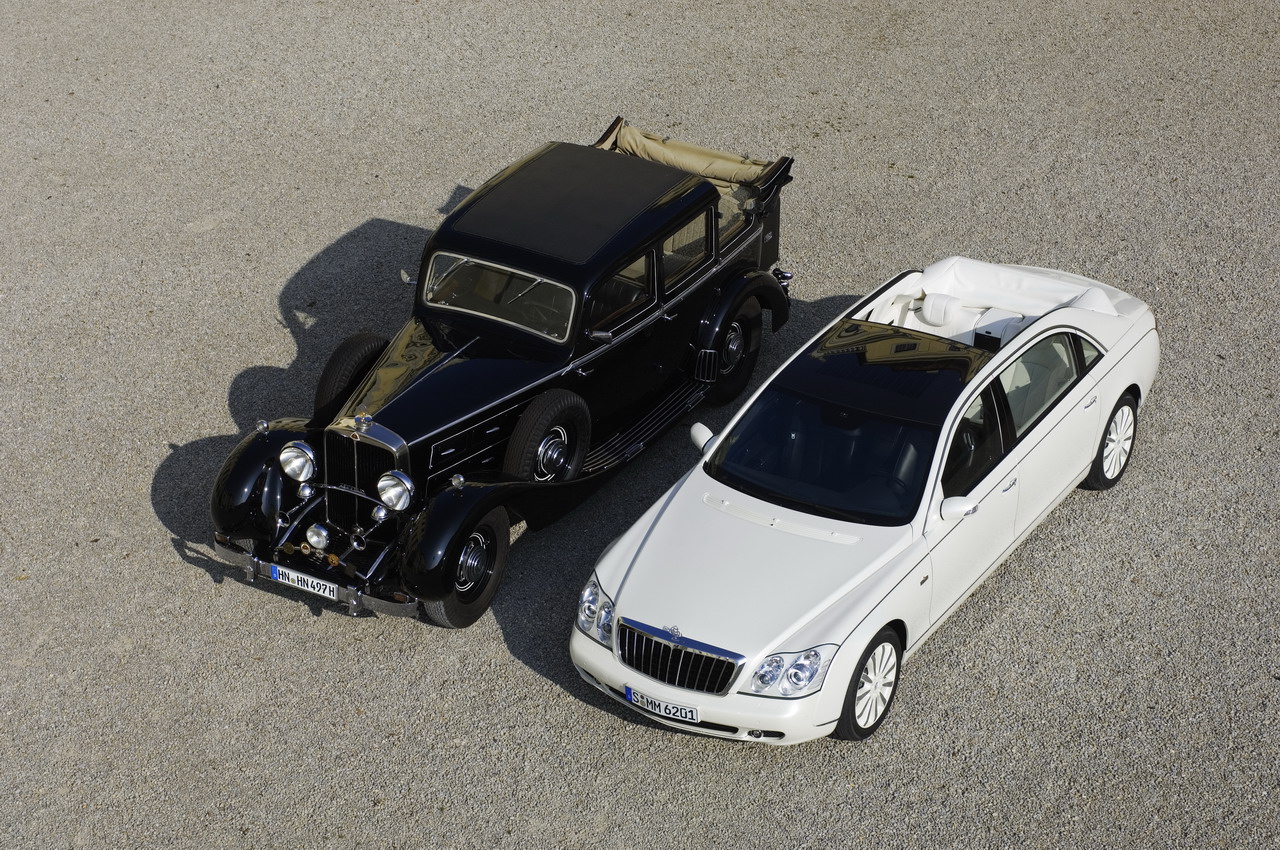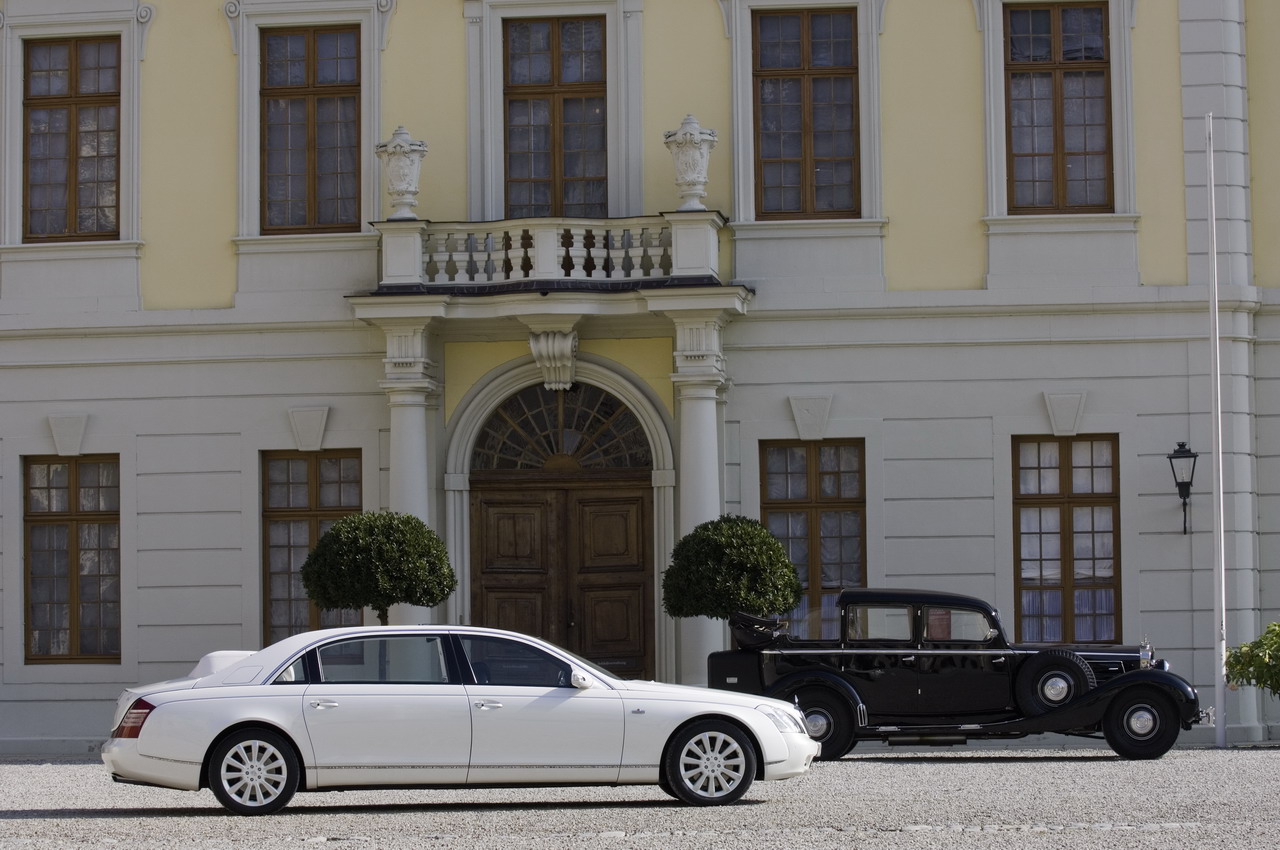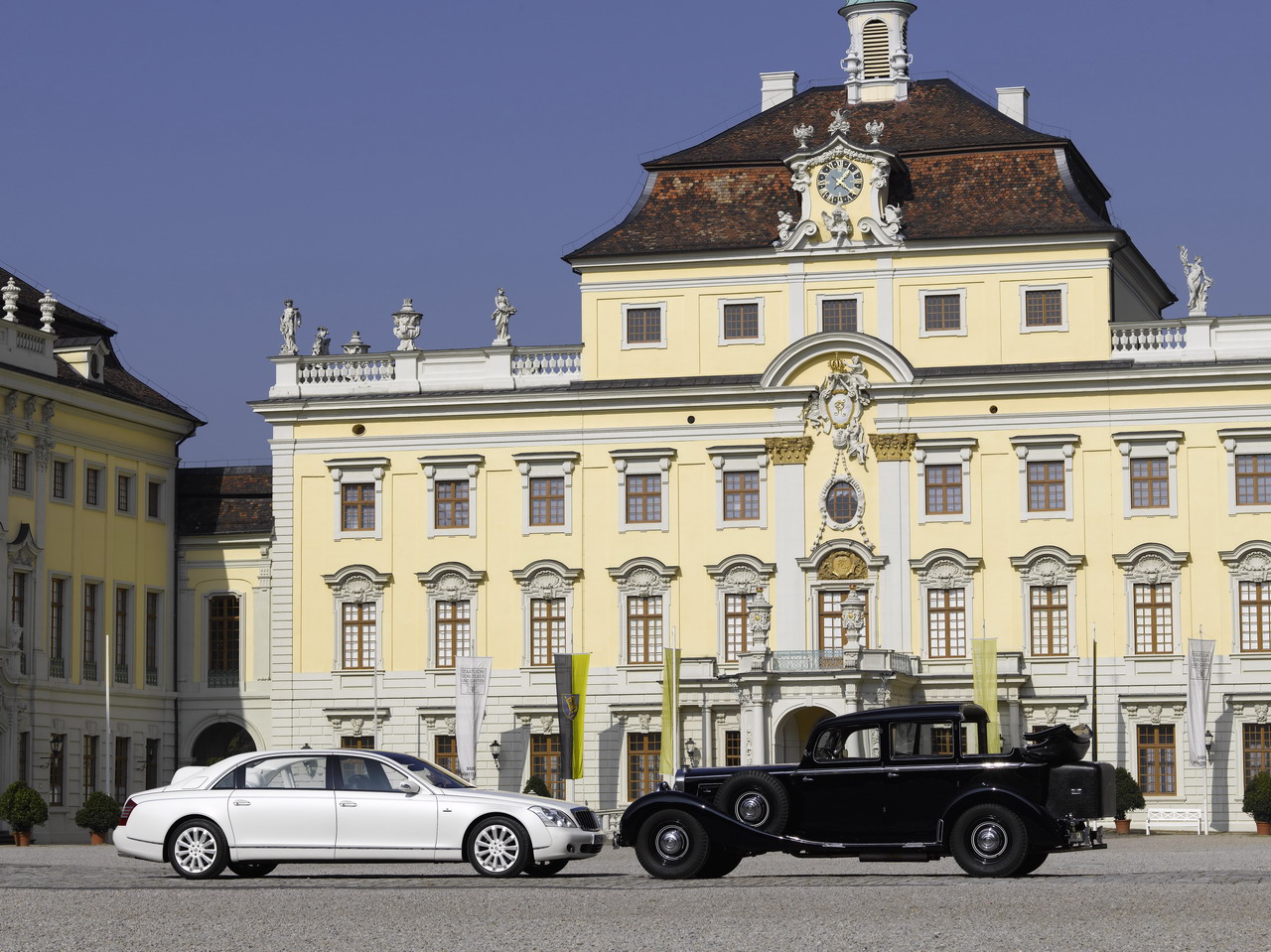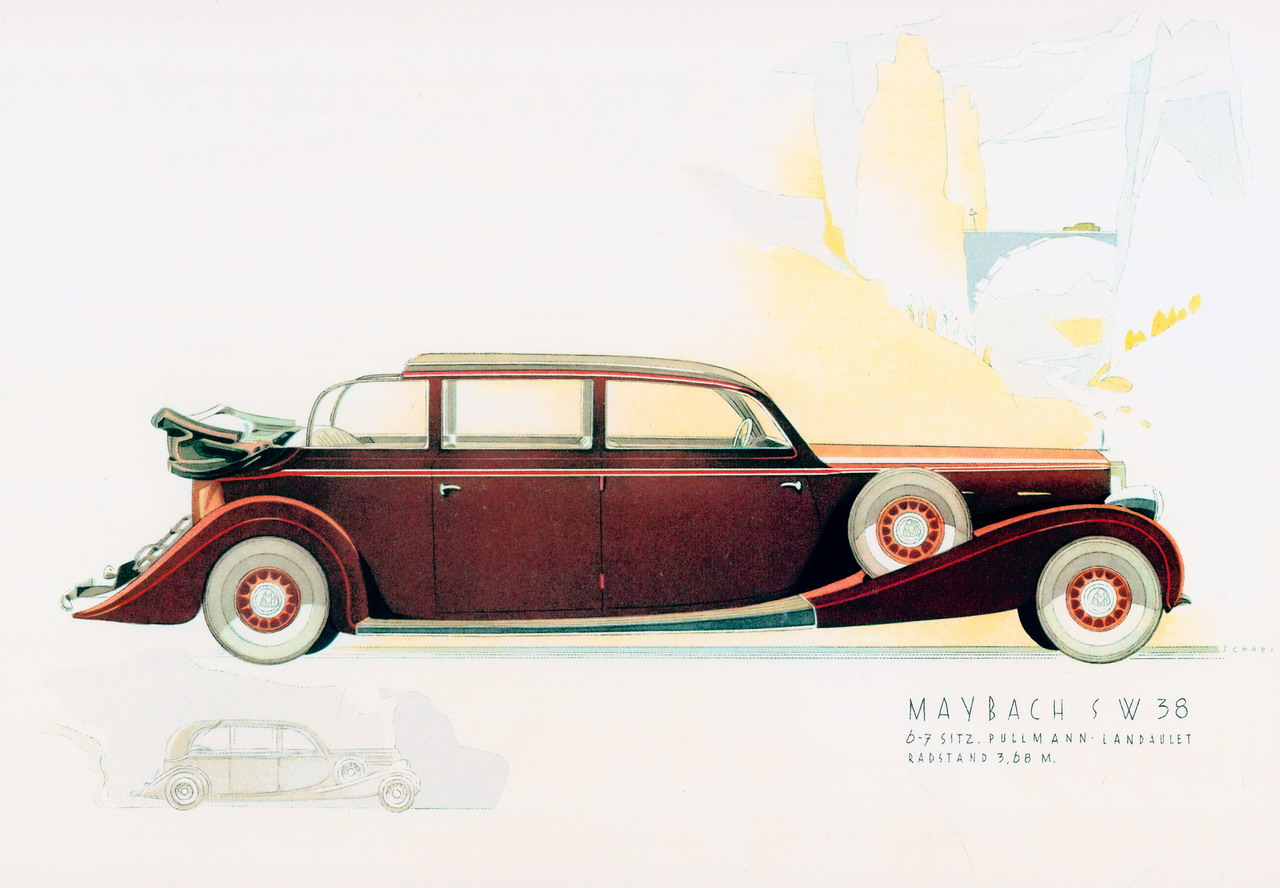
OFFICIAL PRESS RELEASE
Stuttgart, Germany, Nov 05, 2007
* Maybach Landaulet study: New take on a traditional body style
* Landaulet tradition at Daimler AG harking back to the days of Daimler and Benz
* Mercedes-Benz 600 the only factory-built landaulet available anywhere in the world from 1965 to 1981
The combination of tradition and modernity embodied in the Maybach Landaulet study, unveiled in November 2007, makes this a truly unique vehicle of its time. The highly unusual body shape already defines the car as something quite out of the ordinary. But the unique combination of the fold-back roof at the rear and a solid roof section over the front seats also reflects the fine appreciation of tradition and values that is the hallmark of the Mercedes Benz Cars approach.
The body of the landaulet harks back to the early days of automotive history. Just a few years after the invention of the automobile by Gottlieb Daimler and Carl Benz in 1886 – working independently of each other – both companies had large numbers of landaulets on the roads. The Mercedes-Benz brand created in 1926 took up the idea, and over the years landaulets based on a range of model were built, both in normal production plants and by prestigious bodybuilders. The last landaulet variant available as a production car was the 600 model (W 100 series) from 1965 until 1981. The company’s in-house special vehicle manufacturing workshops also built three different landaulets for the Vatican in the second half of the 20th century.
Distinctive folding top
The landaulet is one of the true aristocrats among special body designs, and indeed its origins go back to the days of the coachbuilder’s art. Its hallmark is a “rigid, closed passenger compartment with a folding convertible top,” according to the Mercedes-Benz definition. What this means in practice is a folding convertible top over the rear seats, adjacent to a rigid top or solid partition. Depending on the variant, the driver might be out in the open, or – as is usual in today’s bodies of this type – in his own compartment, after the style of a limousine.
In any event, the choice between closed or open-top travel is only available to the passengers in the rear. The qualities of the landaulet as the perfect car for public figures are most evident when the opulent roof is swung back, focusing every eye on the occupants in the rear, and converting the landaulet into a stylish and elegant platform for public appearances. This is why vehicles with this unique body design are used almost exclusively by dignitaries and VIPs. And of course the roof can always be closed again, as protection from the weather or prying glances.
Maybach Landaulet study
The Maybach Landaulet study was created in response to requests from Maybach customers who still feel the thrill of landaulet vehicles from the days of sumptuously equipped coaches driving through the streets. The car is based on the Maybach 62 S. The C-pillars and roof arches remain in place when the top is pushed back, retaining the luxury limousine’s distinctive silhouette, along with the generously-dimensioned doors, stylish interior compartment and seating arrangements.
When the roof is closed, the convertible top is stretched over the roof frame, providing a tight seal against wind and weather. On the instruction to open the passenger compartment, the driver merely has to press a control on the center console, and the structure, together with the rear window, folds gently down onto the parcel shelf, without any significant loss of stowage space. The opening and closing of the convertible top is an efficient but unhurried process, like a smoothly choreographed dance, taking around 20 seconds to complete. The luggage compartment remains easily accessible even with the roof open. And the driver can cover the retracted top with a stylish leather tarpaulin, concealing the mechanism and restoring the smooth and elegant contours of the vehicle.
Historical Maybach landaulets
In the 1930s there were landaulet versions of several Maybach luxury limousines. In line with normal practice at the time, the body fitted to the chassis could be designed according to the owner’s individual requirements. The most popular models with landaulet customers were the twelve-cylinder Maybach 12, Maybach Zeppelin DS7 and Maybach Zeppelin DS8. The combination of letters and numerals used for the Zeppelin models stood for the V12 engine (double-six, = DS) and the displacement. The Zeppelin DS7, built in 1930 and 1931, had a 150 hp (110 kW) engine with displacement of 6922 cubic centimeters, while its successor, produced from 1931 to 1939, generated 200 hp (147 kW) from a 7922 cubic centimeter engine.
Nor was the circle of Maybach landaulet aficionados restricted to statesmen and captains of industry. There were others for whom maintaining a high public profile was a business necessity, and an automobile that could put its occupants on show like jewels in a display case simply by folding the roof back was clearly ideal for the purpose. For example, in 1930 the Sembach-Krone family commissioned the Erdmann & Rossi bodybuilders’ firm to build a Zeppelin DS7, specifying a burgundy-colored landaulet body, as a management vehicle for the legendary Krone circus. This elegant car with its long folding top is now on show at the Sinsheim Auto and Technology Museum.
Also featured in the Sinsheim collection is a 1938 landaulet version of the Zeppelin DS8 with a top speed of 160 km/h. This body, with a short folding top, was made by Hermann Spohn in Ravensburg. Spohn was the regular bodybuilder for Maybach, located just twenty kilometers away in Friedrichshafen.



Copyright © 2008, Mercedes-Benz-Blog. All rights reserved.
Search
Archives
-
▼
2008
(1138)
-
▼
September
(125)
- The AMG Driving Academy [3 TEXTS]
- More Service With Free SetraCard
- Mercedes, 180° from expected. The GLK.
- Mercedes-Benz SLR McLaren Roadster 722 S: Thrillin...
- F1 Singapore - SUN - The Race - Lewis Hamilton Ext...
- F1 Singapore - SAT - Qualifying - Lewis Hamilton o...
- SPY:2011 CLS-Klasse
- DAY 1:Exclusive photos from Singapore
- F1 Singapore - FRI - Free Practice
- Mercedes-Benz design competition accompanies GLK m...
- Mercedes-Benz BlueTec EEV trucks
- First global Daimler Trucks and Buses Supplier Dia...
- F1 Singapore - Official Schedule
- Mercedes-Benz Trucks: trucks you can trust
- The "Trust Edition" - high-class workmanship from ...
- Vodafone McLaren Mercedes Statement
- Mercedes-Benz Trucker Selection: practical and sty...
- Improved safety in the dark: The new adaptive high...
- Daimler AG at InnoTrans in Berlin
- Statement on Daimler stake in Chrysler
- Actros voted “Truck of the Year 2009”
- Mercedes-Benz IPTV Weekly Show 23.09.2008
- Preview:2012 Mercedes-Benz GLA
- SPY:2011 SLC
- DTM Barcelona - The Race - Paul Di Resta Wins with...
- DTM Barcelona - Qualifying - 25th pole for Bernd S...
- SPY + CGI:2009 E-Klasse
- VIDEO:Mercedes-Benz S 400 BlueHYBRID
- DTM Barcelona - Preview
- F1 Singapore - Preview
- 2009 E-Klasse:Official or not?
- Daimler Financial Services Opens Business in Romania
- Daimler presenting 11 “Green” Commercial Vehicles ...
- CGI:Future E-Klasse Coupe & Cabrio
- Technical Data:The New S 400 BlueHYBRID
- SPY:New photos showcasing the next E 63 AMG
- Mercedes-Benz S 400 BlueHYBRID: The CO2 champion i...
- Mercedes-Benz IPTV Weekly Show 16.09.2008
- SPY:2009 E-Klasse Coupe
- Mercedes-Benz presents the GLK-Class Selection: Se...
- Mercedes-Benz presents itself as a competent After...
- Mercedes-Benz-Blog TRIVIA: 1883: Foundation of Ben...
- VIDEO:Mercedes-Benz C 250 CDI BlueEFFICIENCY
- F1 Monza - SUN - The Race - Heikki Kovalainen second
- VIDEO:ConceptFASCINATION Preview Clip
- F1 Monza - SAT - Qualifying - Heikki Kovalainen on...
- Rumor:2010 Mercedes-Benz CLR
- SPY-W212 + W211
- 2015: 20% of total production=hybrid models
- F1 Monza - FRI - Free Practice
- SPY:2010 SLC
- SPY:Mika Hakkinen and Klaus Ludwig testing the 201...
- Mercedes-Benz ConceptFASCINATION study showcases n...
- Mercedes-Benz ConceptFASCINATION:First high-res wa...
- Mercedes-Benz renaming procedure continues
- ConceptFASCINATION:Studio shots
- Possible name changes for next Mercedes-Benz models
- Mercedes-Benz ConceptFASCINATION:Bigger resolution...
- LEAKED:The impressive Mercedes-Benz ConceptFASCINA...
- Mercedes-Benz-Blog TRIVIA: Mercedes-Benz Classic D...
- F1 Monza - Preview
- Mercedes-Benz Championship in Pulheim near Cologne...
- C 250 CDI BlueEFFICIENCY Prime Edition: Efficiency...
- SPY:Mika Hakkinen goes behind the steering wheel o...
- Vodafone McLaren Mercedes proceeds with the appeal...
- Mercedes-Benz IPTV Weekly Show 09.09.2008
- New SPY photos with the 2010 Flugelturer
- World premiere: the new construction Actros - the ...
- Mercedes-Benz-Blog TRIVIA: Mercedes-Benz Nürburg: ...
- SPY:2010 SLC/AMG Flugelturer
- SPY:Fresh pics of the CLK
- F1 Spa-Francorchamps - SUN - The Race
- Mercedes-Benz-Blog TRIVIA: Mercedes-Benz Classic D...
- What really happened yesterday at Spa
- 7th Sep. 2008 - The day Formula 1 died
- SPY:2010 E-Klasse
- F1 Spa-Francorchamps - SAT - Qualifying - Lewis Ha...
- Mercedes-Benz-Blog TRIVIA: Landaulet: Al fresco mo...
- Mercedes-Benz-Blog TRIVIA:Landaulet: Al fresco mot...
- Mercedes-Benz-Blog TRIVIA:Landaulet: Al fresco mot...
- Mercedes-Benz-Blog TRIVIA:Landaulet: Al fresco mot...
- Mercedes-Benz-Blog TRIVIA:Landaulet: Al fresco mot...
- Mercedes-Benz-Blog TRIVIA: The Research Cars of Me...
- Mercedes-Benz-Blog TRIVIA:The Research Cars of Mer...
- Mercedes-Benz-Blog TRIVIA:The Research Cars of Mer...
- Mercedes-Benz-Blog TRIVIA:The Research Cars of Mer...
- Mercedes-Benz-Blog TRIVIA:The Research Cars of Mer...
- Mercedes-Benz-Blog TRIVIA:The Research Cars of Mer...
- Mercedes-Benz-Blog TRIVIA:The Research Cars of Mer...
- Mercedes-Benz-Blog TRIVIA:The Research Cars of Mer...
- Mercedes-Benz-Blog TRIVIA:The Research Cars of Mer...
- Mercedes-Benz-Blog TRIVIA:The Research Cars of Mer...
- Mercedes-Benz-Blog TRIVIA:The Research Cars of Mer...
- Mercedes-Benz-Blog TRIVIA:The Research Cars of Mer...
- Mercedes-Benz-Blog TRIVIA:The Research Cars of Mer...
- Mercedes-Benz-Blog TRIVIA:The Research Cars of Mer...
- Mercedes-Benz-Blog TRIVIA:The Research Cars of Mer...
- Mercedes-Benz-Blog TRIVIA:The Research Cars of Mer...
- Mercedes-Benz-Blog TRIVIA:The Research Cars of Mer...
- Mercedes-Benz-Blog TRIVIA:The Research Cars of Mer...
-
▼
September
(125)


